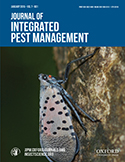[ad_1]
” data-image-caption=”<p>The USDA Forest Service funds hundreds of projects every year to protect our nation’s woodlands. Included in these research projects are several different types of pest management strategies spanning a wide range of pests, forest types, and ecosystems. A new article in the <em>Journal of Integrated Pest Management</em> reviews USFS pest-management research from 2011 to 2020, which helped manage over 2.2 million hectares of forest. (Photo by <a href=”https://www.flickr.com/photos/usforestservice/53288379400/in/album-72177720312228746/”>USDA Forest Service via Flickr</a>, public domain)
The USDA Forest Service funds hundreds of projects every year to protect our nation’s woodlands. Included in these research projects are several different types of pest management strategies spanning a wide range of pests, forest types, and ecosystems. A new article in the Journal of Integrated Pest Management reviews USFS pest-management research from 2011 to 2020, which helped manage over 2.2 million hectares of forest. (Photo by USDA Forest Service via Flickr, public domain)
By David Coyle, Ph.D.
Folks outside the forest entomology realm have likely heard of the USDA Forest Service but may have little knowledge of what this group actually does. Truth be told, they do a lot—from trail and road maintenance to fire suppression and prevention to management, this group is responsible for managing millions of acres of our nation’s forestland. But, in addition to the management aspect, the Forest Service (USFS) also conducts and funds research—lots of research. In an article published in October in the Journal of Integrated Pest Management , several USFS scientists summarize the past decade’s USFS-funded forest health management, and, frankly, the impacts on U.S. forests are impressive.
Forest Health Protection is a unit of the USFS State, Private, and Tribal Forestry Deputy Area, and this group regularly works with personnel from academia, government, industry, and nonprofit organizations to monitor pests and improve management of forests. New and existing grants are funded annually, and, while many of these projects result in peer-reviewed publications, this is the first time their impact has been summarized in one place.
In total, over 2,400 forest pest-management projects were supported between 2011 and 2020, directly impacting 2,284,624 hectares (5,645,429 acres or 8,821 square miles). The list of pests impacted by this work reads as the Who’s Who of forest health issues and includes native species such as the mountain and southern pine beetle, Douglas-fir beetle, western spruce budworm, and Ips bark beetles. Invasive pests include the spongy moth, emerald ash borer, and hemlock woolly adelgid. Projects evaluated traditional and novel management methods, and the paper contains a plethora of interesting numbers and facts related to this program—way more than can be adequately summarized here.
” data-image-caption=”<p>The USDA Forest Service funds hundreds of projects every year to protect our nation’s woodlands. Included in these research projects are several different types of pest management strategies spanning a wide range of pests, forest types, and ecosystems. A new article in the <em>Journal of Integrated Pest Management</em> reviews USFS pest-management research from 2011 to 2020, which helped manage over 2.2 million hectares of forest. (Image originally published in Coleman et al 2023, <em>Journal of Integrated Pest Management</em>)
The USDA Forest Service funds hundreds of projects every year to protect our nation’s woodlands. Included in these research projects are several different types of pest management strategies spanning a wide range of pests, forest types, and ecosystems. A new article in the Journal of Integrated Pest Management reviews USFS pest-management research from 2011 to 2020, which helped manage over 2.2 million hectares of forest. (Image originally published in Coleman et al 2023, Journal of Integrated Pest Management)
But, as someone who works in the forest health realm and who works with the USFS very frequently, a few points are worth highlighting. First, the tables and figures alone in this paper hold so much information on where federal funding goes and what it impacts. This is a common criticism from those who might not appreciate what our federal government does or where tax dollars go, and this paper goes a long way to help answer some of these questions as they pertain to USFS work. From the data, it seems clear that a lot is being done because of this program. Second, the question of where in the country our federal dollars go is also largely answered, as the authors clearly break down where the projects took place, acres impacted in each region, and several other location-specific bits of information. Finally, the comprehensive nature of this program is well-documented in this paper. It’s not just bark beetles, or defoliators, or native or invasive species—it’s all of them at the same time. It’s broad-scale forest health work, which is an excellent goal and objective for an entity such as the USDA Forest Service.
Whether you work in forests or not, this paper does an excellent job of summarizing a decade of government-supported integrated pest management work.
David Coyle, Ph.D., is an assistant professor in the Department of Forestry and Environmental Conservation at Clemson University. Find him on all the socials as @drdavecoyle. Email: dcoyle@clemson.edu.
[ad_2]
